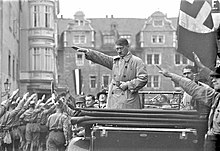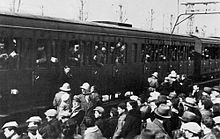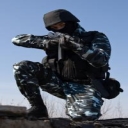![]() Published in Georgia - Social interactions and entertainment - 10 Jun 2016 03:41 - 3
Published in Georgia - Social interactions and entertainment - 10 Jun 2016 03:41 - 3
World War II (WWII or WW2), also known as the Second World War, was a global war that lasted from 1939 to 1945, although related conflicts began earlier. It involved the vast majority of the world's nations—including all of the great powers—eventually forming two opposing military alliances: the Allies and the Axis. It was the most widespread war in history, and directly involved more than 100 million people from over 30 countries. In a state of "total war", the major participants threw their entire economic, industrial, and scientific capabilities behind the war effort, erasing the distinction between civilian and military resources. Marked by m deaths of civilians, including the Holocaust (in which approximately 11 million people were killed) and the strategic bombing of industrial and lation centres (in which approximately one million were killed, and which included the atomic bombings of Hiroshima and Nagasaki), it resulted in an estimated 50 million to 85 million fatalities. These made World War II the deadliest conflict in human history.The Empire of Japan aimed to dominate Asia and the Pacific and was already at war with the Republic of China in 1937,but the world war is generally said to have begun on 1 September 1939 with the invasion of Poland by Germany and subsequent declarations of war on Germany by France and the United Kingdom. From late 1939 to early 1941, in a series of campaigns and treaties, Germany conquered or controlled much of continental Europe, and formed the Axis alliance withItaly and Japan. Under the Molotov–Ribbentrop Pact of August 1939, Germany and the Soviet Union partitioned and annexed territories of their European neighbours, Poland, Finland, Romania and the Baltic states. The war continued primarily between the European Axis powers and the coalition of the United Kingdom and the British Commonwealth, with campaigns including the North Africa and East Africa campaigns, the aerial Battle of Britain, the Blitz bombing campaign, theBalkan Campaign as well as the long-running Battle of the Atlantic. In June 1941, the European Axis powers launched an invasion of the Soviet Union, opening the largest land theatre of war in history, which trapped the major part of the Axis' military forces into a war of attrition. In December 1941, Japan attacked the United States and European territories in the Pacific Ocean, and quickly conquered much of the Western Pacific.The Axis advance halted in 1942 when Japan lost the critical Battle of Midway, near Hawaii, and Germany was defeated inNorth Africa and then, decisively, at Stalingrad in the Soviet Union. In 1943, with a series of German defeats on the Eastern Front, the Allied invasion of Sicily and the Allied invasion of Italy which brought about Italian surrender, and Allied victories in the Pacific, the Axis lost the initiative and undertook strategic retreat on all fronts. In 1944, the Western Allies invaded German-occupied France, while the Soviet Union regained all of its territorial losses and invaded Germany and its allies. During 1944 and 1945 the Japanese suffered major reverses in mainland Asia in South Central China and Burma, while the Allies crippled the Japanese Navy and captured key Western Pacific islands.The war in Europe concluded with an invasion of Germany by the Western Allies and the Soviet Union, culminating in thecapture of Berlin by Soviet and Polish troops and the subsequent German unconditional surrender on 8 May 1945. Following the Potsdam Declaration by the Allies on 26 July 1945 and the refusal of Japan to surrender under its terms, the United States dropped atomic bombs on the Japanese cities of Hiroshima and Nagasaki on 6 August and 9 August respectively. With an invasion of the Japanese archipelago imminent, the possibility of additional atomic bombings, and the Soviet Union's declaration of war on Japan and invasion of Manchuria, Japan surrendered on 15 August 1945. Thus ended the war in Asia, cementing the total victory of the Allies.World War II altered the political alignment and social structure of the world. The United Nations (UN) was established to foster international co-operation and prevent future conflicts. The victorious great powers—the United States, the Soviet Union, China, the United Kingdom, and France—became the permanent members of the United Nations Security Council.The Soviet Union and the United States emerged as rival superpowers, setting the stage for the Cold War, which lasted for the next 46 years. Meanwhile, the influence of European great powers waned, while the decolonisation of Asia and Africabegan. Most countries whose industries had been damaged moved towards economic recovery. Political integration, especially in Europe, emerged as an effort to end pre-war enmities and to create a common identity.
Commanders and leaders
ChronologySee also: Timeline of World War IIThe start of the war in Europe is generally held to be 1 September 1939, beginning with the German invasion of Poland; Britain and France declared war on Germany two days later. The dates for the beginning of war in the Pacific include the start of the Second Sino-Japanese War on 7 July 1937, or even the Japanese invasion of Manchuria on 19 September 1931.Others follow the British historian A. J. P. Taylor, who held that the Sino-Japanese War and war in Europe and its colonies occurred simultaneously and the two wars merged in 1941. This article uses the conventional dating. Other starting dates sometimes used for World War II include the Italian invasion of Abyssinia on 3 October 1935. The British historian Antony Beevor views the beginning of the Second World War as the Battles of Khalkhin Gol fought between Japan and the forces of Mongolia and the Soviet Union from May to September 1939.The exact date of the war's end is also not universally agreed upon. It was generally accepted at the time that the war ended with the armistice of 14 August 1945 (V-J Day), rather than the formal surrender of Japan (2 September 1945). A peace treaty with Japan was signed in 1951 to formally tie up any loose ends such as compensation to be paid to Allied prisoners of war who had been victims of atrocities. A treaty regarding Germany's future allowed the reunification of East and West Germany to take place in 1990 and resolved other post-World War II issues.
EuropeWorld War I had radically altered the political European map, with the defeat of the Central Powers—including Austria-Hungary, Germany and the Ottoman Empire—and the 1917Bolshevik seizure of power in Russia, which eventually led to the founding of the Soviet Union. Meanwhile, the victorious Allies of World War I, such as France, Belgium, Italy, Greece and Romania, gained territory, and new nation-states were created out of the collapse of Austria-Hungary and the Ottoman and Russian Empires.To prevent a future world war, the League of Nations was created during the 1919 Paris Peace Conference. The organisation's primary goals were to prevent armed conflict through collective security, military and naval disarmament, and settling international disputes through peaceful negotiations and arbitration.
 Despite strong pacifist sentiment after World War I, its aftermath still caused irredentist and revanchist nationalism in several European states. These sentiments were especially marked in Germany because of the significant territorial, colonial, and financial losses incurred by the Treaty of Versailles. Under the treaty, Germany lost around 13 percent of its home territory and all of its overseas colonies, while German annexation of other states was prohibited, reparations were imposed, and limits were placed on the size and capability of the country's armed forces.The German Empire was dissolved in the German Revolution of 1918–1919, and a democratic government, later known as the Weimar Republic, was created. The interwar period saw strife between supporters of the new republic and hardline opponents on both the rightand left. Italy, as an Entente ally, had made some post-war territorial gains; however, Italian nationalists were angered that the promises made by Britain and France to secure Italian entrance into the war were not fulfilled with the peace settlement. From 1922 to 1925, theFascist movement led by Benito Mussolini seized power in Italy with a nationalist, totalitarian, and cl collaborationist agenda that abolished representative democracy, repressed socialist, left-wing and liberal forces, and pursued an aggressive expansionist foreign policy aimed at making Italy a world power, promising the creation of a "New Roman Empire".
Despite strong pacifist sentiment after World War I, its aftermath still caused irredentist and revanchist nationalism in several European states. These sentiments were especially marked in Germany because of the significant territorial, colonial, and financial losses incurred by the Treaty of Versailles. Under the treaty, Germany lost around 13 percent of its home territory and all of its overseas colonies, while German annexation of other states was prohibited, reparations were imposed, and limits were placed on the size and capability of the country's armed forces.The German Empire was dissolved in the German Revolution of 1918–1919, and a democratic government, later known as the Weimar Republic, was created. The interwar period saw strife between supporters of the new republic and hardline opponents on both the rightand left. Italy, as an Entente ally, had made some post-war territorial gains; however, Italian nationalists were angered that the promises made by Britain and France to secure Italian entrance into the war were not fulfilled with the peace settlement. From 1922 to 1925, theFascist movement led by Benito Mussolini seized power in Italy with a nationalist, totalitarian, and cl collaborationist agenda that abolished representative democracy, repressed socialist, left-wing and liberal forces, and pursued an aggressive expansionist foreign policy aimed at making Italy a world power, promising the creation of a "New Roman Empire".
 hitler at a germany national socialist political rally, 1930
hitler at a germany national socialist political rally, 1930
Adolf Hitler, after an unsuccessful attempt to overthrow the German government in 1923, eventually became the Chancellor of Germany in 1933. He abolished democracy, espousing a radical, racially motivated revision of the world order, and soon began a miverearmament campaign. It was at this time that political scientists began to predict that a second Great War might take place.Meanwhile, France, to secure its alliance, allowed Italy a free hand in Ethiopia, which Italy desired as a colonial possession. The situation was aggravated in early 1935 when the Territory of the Saar Basin was legally reunited with Germany and Hitler repudiated the Treaty of Versailles, accelerated his rearmament programme, and introduced conscription.Hoping to contain Germany, the United Kingdom, France and Italy formed the Stresa Front; however, in June 1935, the United Kingdom made an independent naval agreement with Germany, easing prior restrictions. The Soviet Union, concerned by Germany's goals of capturing vast areas of eastern Europe, drafted a treaty of mutual istance with France. Before taking effect though, the Franco-Soviet pact was required to go through the bureaucracy of the League of Nations, which rendered it essentially toothless. The United States, concerned with events in Europe and Asia, ped the Neutrality Act in August of the same year.Hitler defied the Versailles and Locarno treaties by remilitarising the Rhineland in March 1936. He encountered little opposition from other European powers. In October 1936, Germany and Italy formed the Rome–Berlin Axis. A month later, Germany and Japan signed the Anti-Comintern Pact, which Italy would join in the following year.AsiaThe Kuomintang (KMT) party in China launched a unification campaign against regional warlords and nominally unified China in the mid-1920s, but was soon embroiled in a civil war against its former Chinese communist allies. In 1931, an increasingly militaristic Japanese Empire, which had long sought influence in China as the first step of what its government saw as the country's right to rule Asia, used the Mukden Incident as a pretext to launch an invasion of Manchuria and establish the puppet state of Manchukuo.Too weak to resist Japan, China appealed to the League of Nations for help. Japan withdrew from the League of Nations after being condemned for its incursion into Manchuria. The two nations then fought several battles, in Shanghai, Rehe and Hebei, until the Tanggu Truce was signed in 1933. Thereafter, Chinese volunteer forces continued the resistance to Japanese aggression in Manchuria, and Chahar and Suiyuan. After the 1936 Xi'an Incident, the Kuomintang and communist forces agreed on a ceasefire to present a united front to oppose Japan.
Pre-war eventsItalian invasion of Ethiopia (1935)
The Second Italo–Abyssinian War was a brief colonial war that began in October 1935 and ended in May 1936. The war began with the invasion of the Ethiopian Empire (also known as Abyssinia) by the armed forces of the Kingdom of Italy (Regno d'Italia), which was launched from Italian Somaliland and Eritrea. The war resulted in the military occupation of Ethiopia and its annexation into the newly created colony of Italian East Africa (Africa Orientale Italiana, or AOI); in addition, it exposed the weakness of the League of Nations as a force to preserve peace. Both Italy and Ethiopia were member nations, but the League did nothing when the former clearly violated the League's own Article X. Germany was the only major European nation to support the invasion. Italy subsequently dropped its objections to Germany's goal of absorbing Austria. italian soldiers, 1935
italian soldiers, 1935
Spanish Civil War (1936–39)
When civil war broke out in Spain, Hitler and Mussolini lent military support to the Nationalist rebels, led by General Francisco Franco. The Soviet Union supported the existing government, the Spanish Republic. Over 30,000 foreign volunteers, known as the International Brigades, also fought against the Nationalists. Both Germany and the USSR used this proxy war as an opportunity to test in combat their most advanced weapons and tactics. The bombing of Guernica by the German Condor Legion in April 1937 heightened widespread concerns that the next major war would include extensive terror bombing attacks on civilians. The Nationalists won the civil war in April 1939; Franco, now dictator, bargained with both sides during the Second World War, but never concluded any major agreements. He did send volunteers to fight on the Eastern Front under German command but Spain remained neutral and did not allow either side to use its territory.
Japanese invasion of China (1937
In July 1937, Japan captured the former Chinese imperial capital of Beijing after instigating theMarco Polo Bridge Incident, which culminated in the Japanese campaign to invade all of China.The Soviets quickly signed a non-aggression pact with China to lend materiel support, effectively ending China's prior co-operation with Germany. Generalissimo Chiang Kai-shek deployed his best army to defend Shanghai, but, after three months of fighting, Shanghai fell. The Japanese continued to push the Chinese forces back, capturing the capital Nanking in December 1937. After the fall of Nanking, tens of thousands if not hundreds of thousands of Chinese civilians and disarmed combatants were murdered by the Japanese.In March 1938, Nationalist Chinese forces won their first major victory at Taierzhuang but then the city of Xuzhou was taken by Japanesein May. In June 1938, Chinese forces stalled the Japanese advance by flooding the Yellow River; this manoeuvre bought time for the Chinese to prepare their defences at Wuhan, but the city was taken by October. Japanese military victories did not bring about the collapse of Chinese resistance that Japan had hoped to achieve; instead the Chinese government relocated inland to Chongqing and continued the war.
Commanders and leaders
ChronologySee also: Timeline of World War IIThe start of the war in Europe is generally held to be 1 September 1939, beginning with the German invasion of Poland; Britain and France declared war on Germany two days later. The dates for the beginning of war in the Pacific include the start of the Second Sino-Japanese War on 7 July 1937, or even the Japanese invasion of Manchuria on 19 September 1931.Others follow the British historian A. J. P. Taylor, who held that the Sino-Japanese War and war in Europe and its colonies occurred simultaneously and the two wars merged in 1941. This article uses the conventional dating. Other starting dates sometimes used for World War II include the Italian invasion of Abyssinia on 3 October 1935. The British historian Antony Beevor views the beginning of the Second World War as the Battles of Khalkhin Gol fought between Japan and the forces of Mongolia and the Soviet Union from May to September 1939.The exact date of the war's end is also not universally agreed upon. It was generally accepted at the time that the war ended with the armistice of 14 August 1945 (V-J Day), rather than the formal surrender of Japan (2 September 1945). A peace treaty with Japan was signed in 1951 to formally tie up any loose ends such as compensation to be paid to Allied prisoners of war who had been victims of atrocities. A treaty regarding Germany's future allowed the reunification of East and West Germany to take place in 1990 and resolved other post-World War II issues.
EuropeWorld War I had radically altered the political European map, with the defeat of the Central Powers—including Austria-Hungary, Germany and the Ottoman Empire—and the 1917Bolshevik seizure of power in Russia, which eventually led to the founding of the Soviet Union. Meanwhile, the victorious Allies of World War I, such as France, Belgium, Italy, Greece and Romania, gained territory, and new nation-states were created out of the collapse of Austria-Hungary and the Ottoman and Russian Empires.To prevent a future world war, the League of Nations was created during the 1919 Paris Peace Conference. The organisation's primary goals were to prevent armed conflict through collective security, military and naval disarmament, and settling international disputes through peaceful negotiations and arbitration.
 Despite strong pacifist sentiment after World War I, its aftermath still caused irredentist and revanchist nationalism in several European states. These sentiments were especially marked in Germany because of the significant territorial, colonial, and financial losses incurred by the Treaty of Versailles. Under the treaty, Germany lost around 13 percent of its home territory and all of its overseas colonies, while German annexation of other states was prohibited, reparations were imposed, and limits were placed on the size and capability of the country's armed forces.The German Empire was dissolved in the German Revolution of 1918–1919, and a democratic government, later known as the Weimar Republic, was created. The interwar period saw strife between supporters of the new republic and hardline opponents on both the rightand left. Italy, as an Entente ally, had made some post-war territorial gains; however, Italian nationalists were angered that the promises made by Britain and France to secure Italian entrance into the war were not fulfilled with the peace settlement. From 1922 to 1925, theFascist movement led by Benito Mussolini seized power in Italy with a nationalist, totalitarian, and cl collaborationist agenda that abolished representative democracy, repressed socialist, left-wing and liberal forces, and pursued an aggressive expansionist foreign policy aimed at making Italy a world power, promising the creation of a "New Roman Empire".
Despite strong pacifist sentiment after World War I, its aftermath still caused irredentist and revanchist nationalism in several European states. These sentiments were especially marked in Germany because of the significant territorial, colonial, and financial losses incurred by the Treaty of Versailles. Under the treaty, Germany lost around 13 percent of its home territory and all of its overseas colonies, while German annexation of other states was prohibited, reparations were imposed, and limits were placed on the size and capability of the country's armed forces.The German Empire was dissolved in the German Revolution of 1918–1919, and a democratic government, later known as the Weimar Republic, was created. The interwar period saw strife between supporters of the new republic and hardline opponents on both the rightand left. Italy, as an Entente ally, had made some post-war territorial gains; however, Italian nationalists were angered that the promises made by Britain and France to secure Italian entrance into the war were not fulfilled with the peace settlement. From 1922 to 1925, theFascist movement led by Benito Mussolini seized power in Italy with a nationalist, totalitarian, and cl collaborationist agenda that abolished representative democracy, repressed socialist, left-wing and liberal forces, and pursued an aggressive expansionist foreign policy aimed at making Italy a world power, promising the creation of a "New Roman Empire". hitler at a germany national socialist political rally, 1930
hitler at a germany national socialist political rally, 1930Adolf Hitler, after an unsuccessful attempt to overthrow the German government in 1923, eventually became the Chancellor of Germany in 1933. He abolished democracy, espousing a radical, racially motivated revision of the world order, and soon began a miverearmament campaign. It was at this time that political scientists began to predict that a second Great War might take place.Meanwhile, France, to secure its alliance, allowed Italy a free hand in Ethiopia, which Italy desired as a colonial possession. The situation was aggravated in early 1935 when the Territory of the Saar Basin was legally reunited with Germany and Hitler repudiated the Treaty of Versailles, accelerated his rearmament programme, and introduced conscription.Hoping to contain Germany, the United Kingdom, France and Italy formed the Stresa Front; however, in June 1935, the United Kingdom made an independent naval agreement with Germany, easing prior restrictions. The Soviet Union, concerned by Germany's goals of capturing vast areas of eastern Europe, drafted a treaty of mutual istance with France. Before taking effect though, the Franco-Soviet pact was required to go through the bureaucracy of the League of Nations, which rendered it essentially toothless. The United States, concerned with events in Europe and Asia, ped the Neutrality Act in August of the same year.Hitler defied the Versailles and Locarno treaties by remilitarising the Rhineland in March 1936. He encountered little opposition from other European powers. In October 1936, Germany and Italy formed the Rome–Berlin Axis. A month later, Germany and Japan signed the Anti-Comintern Pact, which Italy would join in the following year.AsiaThe Kuomintang (KMT) party in China launched a unification campaign against regional warlords and nominally unified China in the mid-1920s, but was soon embroiled in a civil war against its former Chinese communist allies. In 1931, an increasingly militaristic Japanese Empire, which had long sought influence in China as the first step of what its government saw as the country's right to rule Asia, used the Mukden Incident as a pretext to launch an invasion of Manchuria and establish the puppet state of Manchukuo.Too weak to resist Japan, China appealed to the League of Nations for help. Japan withdrew from the League of Nations after being condemned for its incursion into Manchuria. The two nations then fought several battles, in Shanghai, Rehe and Hebei, until the Tanggu Truce was signed in 1933. Thereafter, Chinese volunteer forces continued the resistance to Japanese aggression in Manchuria, and Chahar and Suiyuan. After the 1936 Xi'an Incident, the Kuomintang and communist forces agreed on a ceasefire to present a united front to oppose Japan.
Pre-war eventsItalian invasion of Ethiopia (1935)
The Second Italo–Abyssinian War was a brief colonial war that began in October 1935 and ended in May 1936. The war began with the invasion of the Ethiopian Empire (also known as Abyssinia) by the armed forces of the Kingdom of Italy (Regno d'Italia), which was launched from Italian Somaliland and Eritrea. The war resulted in the military occupation of Ethiopia and its annexation into the newly created colony of Italian East Africa (Africa Orientale Italiana, or AOI); in addition, it exposed the weakness of the League of Nations as a force to preserve peace. Both Italy and Ethiopia were member nations, but the League did nothing when the former clearly violated the League's own Article X. Germany was the only major European nation to support the invasion. Italy subsequently dropped its objections to Germany's goal of absorbing Austria.
 italian soldiers, 1935
italian soldiers, 1935Spanish Civil War (1936–39)
When civil war broke out in Spain, Hitler and Mussolini lent military support to the Nationalist rebels, led by General Francisco Franco. The Soviet Union supported the existing government, the Spanish Republic. Over 30,000 foreign volunteers, known as the International Brigades, also fought against the Nationalists. Both Germany and the USSR used this proxy war as an opportunity to test in combat their most advanced weapons and tactics. The bombing of Guernica by the German Condor Legion in April 1937 heightened widespread concerns that the next major war would include extensive terror bombing attacks on civilians. The Nationalists won the civil war in April 1939; Franco, now dictator, bargained with both sides during the Second World War, but never concluded any major agreements. He did send volunteers to fight on the Eastern Front under German command but Spain remained neutral and did not allow either side to use its territory.
Japanese invasion of China (1937
In July 1937, Japan captured the former Chinese imperial capital of Beijing after instigating theMarco Polo Bridge Incident, which culminated in the Japanese campaign to invade all of China.The Soviets quickly signed a non-aggression pact with China to lend materiel support, effectively ending China's prior co-operation with Germany. Generalissimo Chiang Kai-shek deployed his best army to defend Shanghai, but, after three months of fighting, Shanghai fell. The Japanese continued to push the Chinese forces back, capturing the capital Nanking in December 1937. After the fall of Nanking, tens of thousands if not hundreds of thousands of Chinese civilians and disarmed combatants were murdered by the Japanese.In March 1938, Nationalist Chinese forces won their first major victory at Taierzhuang but then the city of Xuzhou was taken by Japanesein May. In June 1938, Chinese forces stalled the Japanese advance by flooding the Yellow River; this manoeuvre bought time for the Chinese to prepare their defences at Wuhan, but the city was taken by October. Japanese military victories did not bring about the collapse of Chinese resistance that Japan had hoped to achieve; instead the Chinese government relocated inland to Chongqing and continued the war.
Support
Comments (3)





